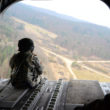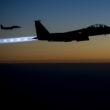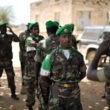ONE OF THE ACCOMPLISHMENTS for which George W. Bush does not get enough credit is his role in restarting the Cold War. Using an Iranian intercontinental ballistic missile (ICBM) program as a pretext, the Bush-Cheney White House is putting in place an anti-ballistic-missile system that targets Iranian ICBMs but is ideally positioned to take out Russian missiles launched from west of the Ural Mountains.
At a cost of $10 billion a year (set to increase to $12-$18 billion over the next ten years) the program seems modest compared to the $750 billion defense budget, although the total cost of the program will be as much as $420 billion when it is fully deployed. And that’s assuming full deployment is what we see on the drawing boards—which is questionable, considering the system’s built-in “upgradability.”
Before you get too excited about a radar-and-rocket umbrella that will protect you from both Iranian ICBMs (which do not and may never exist) and Russian missiles, you should know that the system won’t work. Its seven-of-thirteen kills, in tests so pre-programmed that they bear little relationship to intercepting a warhead flying eight kilometers per second high above the earth’s atmosphere, have been widely reported. Testing is currently on hold.
Ronald Reagan promised a missile-defense solution “well within our grasp,” and dismissed “spending arithmetic” and “numbers and percentages.” But the technology Reagan touted is as elusive today as it was then—even after as much as $150 billion has been poured into it. As they race to put a system in place before the clock runs out, George W. Bush’s missile-defense team is demonstrating an evident lack of concern about the spending arithmetic.
Missile defense is an article of faith for the Republican right. Congressman Trent Franks (R-AZ) tells his colleagues that interceptors have hit 26 of 27 test targets. He fails to mention that this was testing of the “short range” missile defense system, a tactical defense system that is much more realistic. He points to the Navy taking out an errant satellite with one missile, which has nothing to do with missile defense. Franks also raises the specter of a single missile hitting New York City, which is not even a remote possibility for the Iranians. Yet it is entirely possible for the Russians—who are both threatened and antagonized by our anti-ICBM-missile defense program. Observing the central tenet of Dick Cheney’s “One Percent Doctrine”—there is a one percent chance that the Iranians will develop an ICBM—Franks says that the risks far outweigh the costs.
It’s a safe bet that nothing changes between now and January 2009, when the Bushes return to the ranch in Crawford (or more likely a new home in Dallas). But testimony at two Congressional hearings suggests that Congress might finally be preparing to impose some limits on a program that: ignores the “fly before you buy” mandate governing weapons acquisition; can no longer get by on its $10 billion annual appropriation; keeps much of Russia’s nuclear arsenal on ready alert; has made Norway a Russian nuclear target; and will soon have the Russians targeting sites in Poland and the Czech Republic—if the Poles and Czechs sign treaties that will put radar and interceptors on the ground within their borders.
SAY IT AIN’T SO, JOE—Joseph Cirincione, a nuclear proliferation expert who is president of the Ploughshares Fund, testified on March 5 before the House National Security and Foreign Affairs Subcommittee. He told the committee that the $12.3 billion the Bush White House wants for a program designed to counter threats from medium-range Iranian Shahab 3 missiles is four times the amount Reagan requested to defend against “5,000 Soviet warheads on SS-18 and SS-19 missiles screaming over the [North] Pole, hitting the United States, destroying not just our country but most life on this planet.
Cirincione’s testimony raised questions about why we are spending such sums to defend ourselves against an Iranian ICBM that doesn’t yet exist.
He also described a structural flaw in the appropriations process that funds the project. Because missile defense is not included in the services’ budget, no admiral, general, or under-secretary of defense will look at this year’s $12.3 billion request in the context of a zero-sum game. Were the missile defense appropriation put into the services’ budgets, it would compete with “jets, planes, tanks and replacements for . . . equipment that’s being chewed up in Iraq. . . .”
The Missile Defense Agency has further complicated the process by creating an interceptor that flies (or doesn’t fly) under the appropriations radar because it’s been sold as developmental rather than operational equipment. The component parts of the missile defense system are added one piece at a time, so we can’t expect to fly it before we buy it. Until the system is up and running, we’re required to accept the judgment of the Missile Defense Agency, created when George W. Bush withdrew from the Anti-Ballistic Missile Treaty in 2002. The agency is exempt from standard reporting requirements regarding development and acquisition.
TECHNICAL DIFFICULTIES—In a telephone conference with reporters, Theodore Postol described the various Achilles’ heels of the interceptor system: separating re-entry vehicles; tumbling re-entry vehicles; low-power jammers; radar absorbing material; re-orienting re-entry vehicles to lower their radar cross-section; chaff; balloon decoys.
Postol is a physicist at MIT, where he teaches science, technology and national security policy. He is also the coauthor, with Dr. George Lewis, of a critique of the European-based missile defense system, in the May/June issue of the Bulletin of the Atomic Scientists.
The list of counter-measures that Postol described were all outlined in a declassified 1999 National Intelligence Estimate, which predicted that any nation capable of developing an ICBM would also be able to deploy counter-measures that make it very difficult to intercept a warhead.
Postol is urging members of Congress to require the CIA to explain why counter-measures have disappeared from recent intelligence reports. “They have not been mentioned at all,” he says, “which raises the question of whether there’s a tampering with the intelligence, as we know occurred in regard to the run-up to [the Iraq War in] 2003.”
If susceptibility to counter-measures doesn’t ground the program, the radar should. Assuming that the Czechs buy into the deal, a large X-band radar system will be moved from the Ronald Reagan Ballistic Missile Defense Test Site on Kwajalein Atoll to the Czech Republic, where it will function as the European Mid-Course Radar.
According to Postol, the radar system isn’t up to the task because, as configured, only 5 percent of its antenna face is covered with the X-band modules that emit and receive radiation signals. It is “hopelessly inadequate” for the complex demands that will be made on it, he said. At Kwajalein, the radar system was never used to do the sort of discrimination and tracking that will be required to direct an interceptor at a missile.
The Missile Defense Agency dismissed Postol’s criticism, without refuting the technical details he provided in the April 29 conference call, and in far greater detail in a technical report he presented to the German Physical Society in Europe this February.
The other radar component is located in Fylingdales, on the northeastern coast of England. A forward-based system will be located close to Iran—either in the Republic of Georgia (where it is already encountering opposition from the Russians) or eastern Turkey.
The tracking system makes more sense if it includes the Globus II radar facility, which is not part of the system but is the only radar the U.S. has deployed in Europe that is capable of the complex coordinate discrimination that an anti-ballistic-missile system requires.
When Globus II was moved from Vandenberg Air Force Base in California to Norway in 1998, the Norwegian daily Bergens Tidende reported that it had previously been used in the American missile-defense program, could serve a similar function in Norway, and had been transferred from the intelligence budget to the Air Force budget. It’s new home was classified until the Norwegian government revealed that the radar was located in Vardo. Its use as a source of anti-missile radar would have been a violation of the ABM Treaty.
The Russians have been studying and analyzing the radar at Vardo since it went on-line ten years ago. They know what it does and what it can do. And that’s where we return to the Cold War. Radar systems in Georgia or Turkey—and Norway, near Russian launch sites on the Barents Sea—provide the U.S. with a strategic advantage the Russians cannot afford to ignore.
RUSSIA SEES RED—It’s not just surveillance that concerns the Russians. In the center of the radar installations that surround most of Eastern Europe is the quaintly described “interceptor farm” in northwestern Poland. Those interceptors would work in tandem with a radar site the U.S. is trying to install in Georgia, a former Soviet republic in its own cold—and sometimes hot—war with Russia.
Long before Vladimir Putin left the presidency, George W. Bush reassured his Russian counterpart that the defense system is not designed to intercept Russian missiles. Yet who are the Russians (and the American Congress and public) to believe? Our Missile Defense Agency even understates the performance capability of the interceptors it will plant on the interceptor farm, claiming they will fly a maximum of 6.3 kilometers per second—too slow to catch a Russian ICBM. Postol refutes those performance claims.
The interceptor is derived from a Minuteman missile, carries one-tenth of a Minuteman payload, yet is significantly slower than a Minuteman. “Unless there are substantial parts of the interceptor that are constructed of lead brick, there’s no way that can be the case,” Postol said of the claims of a 6.3 kilometers per second speed. “Interceptor velocity is 8 to 8.5 kilometers per second and perhaps even higher.” A speed that would allow the American interceptor to overtake a Russian ICBM.
Postol suspects that, in setting up the various missile installations, the Bush administration is trying to “establish facts on the ground that will be hard to reverse”: radar that can be vastly upgraded; an interceptor farm of 10 that can easily be expanded to 100; international agreements that allow the U.S. to establish a missile-defense system in the heart of Eastern Europe.
Why, Joe Cirincione asked, are we spending such sums to defend ourselves against an Iranian threat that doesn’t exist? Perhaps because the real goal is to fence Russia in.
That’s how the despotic and dangerous Vladimir Putin sees it, as he clings to power as prime minister while handing over the presidency to Dmitri Medvedev. He will respond to the system as if it were a threat—even if it is so technologically flawed that it could never bring down a Russian (or Iranian) missile.
The Russians assume that the system works, if only because the U.S. has spent so much money on it. “We should not want to encourage Russia to maintain its weapons on ‘launch on warning,'” Dr. Lisbeth Gronlund of the Union of Concerned Scientists told House committee members.
THE NEXT COLD WARRIOR—While Bush is building a missile shield on Russia’s borders (imagine the U.S. reaction to Russia placing forward radar bases in Nova Scotia or an interceptor farm in Saskatchewan), Senator John McCain—who hasn’t even achieved the status of official candidate—has already begun provoking the Russians. And not by one of the on-the-fly gaffes that have become the signature mark of the straight-talking loose cannon.
McCain took on the Kremlin in the most comprehensive foreign policy speech his campaign has produced, arguing that the Russians should be expelled from the Group of Eight. The G8 is the elite club of the world’s largest and most powerful industrial democracies, into which the Russians were inducted in the early 1990s when they came in from the Cold War.
McCain’s undiplomatic attack on Russia was largely ignored in the U.S. media, moving quickly through the news cycle after he delivered his foreign policy speech on March 26 in Los Angeles. The Russians are paying attention. They see McCain’s position as a continuation of the foreign policy of George W. Bush.
Or perhaps something worse.
Yeager Yorkins, a Medvedev adviser who was in Washington making the rounds at the State Department the week before the new president took office, told National Public Radio that McCain’s position is a concern to Medvedev. “If Senator McCain comes as the president of the United States and insists that Russia should be chased out of G8, that’s one agenda,” Yorkins said. “If Senator Obama comes as the president of the United States and says I want better relations with Russia, then it’s another agenda.” (Yorkins said he sees little difference between Obama and Senator Hillary Clinton in regard to the foreign policy the Russians would anticipate.)
Putin clearly got the best of Bush when the two men met at the president’s ranch in Texas during Bush’s first term, and Bush claimed to have looked into Putin’s soul and found him to be a good man. Since then, Russia has become more aggressive in its foreign policy and more despotic at home.
Currently, Russia is supporting a separatist movement in the Abkhazia region of Georgia, where Abkhazians have been issued Russian passports while the Russian army is shooting down Georgian spy aircraft. Putin has been equally despotic at home. Russian reporters investigating the government or allies of Putin literally look over their shoulders as they work. Putin has also used the courts and the police to intimidate and even incarcerate his adversaries. And Putin will be around for a while to come, even as Medvedev replaces him as president and tries to determine how much power he actually has.
To all this, McCain would respond programmatically by isolating the Russians, who in all likelihood would respond with more aggression abroad and even less democracy at home. Even as a hard negotiating position, McCain’s attempt to put the Russians on an ice floe is radical in the extreme. Yet his threat to expel Russia from the G8 is a hollow one. The organization operates by consensus. The European members, in particular France, Italy, Germany, and Great Britain, would be unlikely to go along with a U.S. attempt to throw Russia out. McCain also proposes a “League of Democracies,” from which Russia would be excluded, to bypass the United Nations.
McCain is warning the Russians (and voters here at home) to expect something more extreme than the muscular diplomacy of Bush and Cheney. He’s even complicating Bush’s missile defense program, as potential participants in Poland and the Czech Republic watch the Republican presidential candidate turn up the heat in already volatile Georgia, where Bush contemplates a radar installation that he claims has nothing to do with Russia.






0 Comments